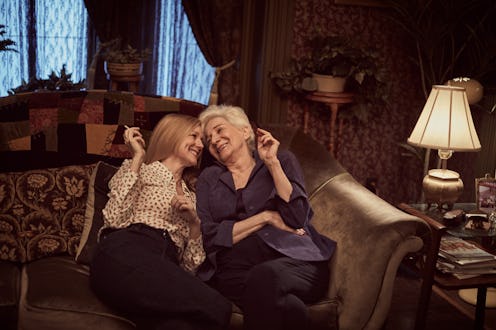Entertainment
A Guide To The Original 'Tales Of The City' For Confused New Netflix Fans

Spoilers ahead for the original Tales of the City miniseries. Not to be confused with Charles Dickens' A Tale of Two Cities, Netflix's Tales of the City — which drops Friday, June 7 — has existed across many iterations and mediums. As outlined by the New York Times, the story began in 1974 with a newspaper column written by Armistead Maupin — first in the Pacific Sun, then the San Francisco Chronicle — and was turned into a novel in 1978. One book became several, some of which were adapted into a miniseries with several installments — Tales of the City in 1993, More Tales of the City in 1998, and Further Tales of the City in 2001. So if you want to know what happened in the original Tales of the City before watching the Netflix revival, it's a little complicated.
The '93 miniseries introduced viewers to a young woman named Mary Ann Singleton (Laura Linney), who impulsively moved from Cleveland to San Francisco in 1976. Once there, she began living at 28 Barbary Lane, whose marijuana-growing landlady is a transgender woman named Anna Madrigal (Olympia Dukakis). The show centered around the inhabitants of the building and their sexual exploits. The cast of characters included Mona Ramsey (Chloe Webb), Brian Hawkins (Slings & Arrows star Paul Gross), and Michael "Mouse" Tolliver (Marcus D'Amico), among others.
The original Tales of the City miniseries (which you can stream on Acorn TV) was incredibly risqué for the '90s, casually featuring nudity, gay sex, and drug use. Predictably, the show received conservative backlash, resulting with PBS dropping the series after its first season, the San Francisco Chronicle reported. As a result, the two subsequent installments aired on Showtime, per the A.V. Club.
1998's More Tales of the City picked up in 1977, according to Variety, and followed both Mary Ann and Mouse going on a cruise to Mexico in order to find love. Mouse reunited with his old flame, Jon Fielding (Bill Campbell), while Mona began working at a brothel, where she unwittingly met her grandma, Mother Mucca, per IMDb. Through this encounter, she learned that Anna Madrigal is her parent. Elsewhere in the season, Mouse came out to his parents in a letter, and Mary Ann's former flame, Beachamp, was killed in a car accident.
As for the third and final installment, the Washington Post reported that Further Tales of the City was set in 1981. Mouse began having casual sex after his breakup with Jon, while Mary Ann was getting ready to marry Brian at the close of the series, per the New York Times. But while the couple did make it down the aisle, it doesn't seem like their marriage stuck, as they've gotten a divorce in the revival. And in one of the series' most bizarre plotlines, cult leader Jim Jones returned from the dead, as an A.V. Club review detailed. The storyline is a bit difficult to explain, but involves the daughter of one of Mary Ann's clients, Diana Leblanc, who everyone thought had died in Jonestown. In other words, Tales of the City was — at its heart — a soap opera.
But while some of the storylines were outlandish, both the book and TV series included frank, groundbreaking depictions of LGBTQ+ characters and their love lives. Maupin told the A.V. Club that while his newspaper column was incredibly popular, there were some concerns about the content. "Gordon Pates, the managing editor of the Chronicle when I first started writing, was so nervous about the multi-sexual nature of the cast that he started keeping a chart that would indicate how many homosexuals and how many heterosexuals were part of the game plan," the author recalled.
Furthermore, Maupin didn't initially reveal that Anna's character was trans because he knew that the editors wouldn't allow it. "I remember Gordon Pates saying to me one time, 'Bisexuality, adultery, homosexuality, [transgenderism] … the only thing you haven't got in this damn thing is cannibalism,'" he told the A.V. Club.
However, Netflix's show is not so much a revival as a continuation, with many of the same characters (including Anna, Mary Ann, and Brian, portrayed by the same actors) returning. "The thing that's wonderful about what's happened now, as opposed to then, is that these stories are now being told by people from the LGBTQ community," Linney, who serves as an executive producer on the Netflix revival, told the Guardian. "All of our writers are queer. All of our directors are queer. That wasn't possible in '93."
As for present-day Tales of the City, the show picks up 20 years after the miniseries' final installment, with Anna's 90th birthday. Mary Ann has returned to town for the occasion, and in doing so, reunites with her estranged daughter, Shawna (Ellen Page), and ex-husband, Brian (Paul Gross). The series will also feature flashbacks to a young Anna, who is played by Jen Richards, an actor who is trans. This time around, Mouse is portrayed by Looking star Murray Bartlett, while Russian Doll breakout Charlie Barnett will play his partner, Ben Marshall. The series also features actors May Hong, Christopher Larkin, Ashley Park, Molly Ringwald, and Zosia Mamet, among others.
So although it's too soon to tell what will happen in this Tales of the City continuation, it will be interesting to see how the inhabitants of 28 Barbary Lane have (or haven't) changed in their 18-year hiatus from television.
This article was originally published on